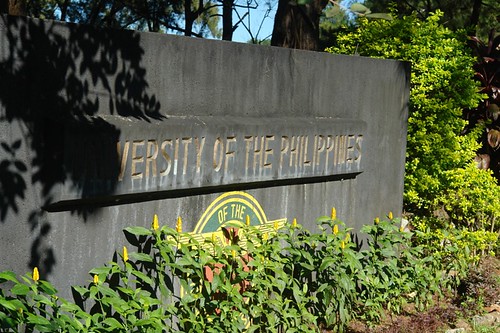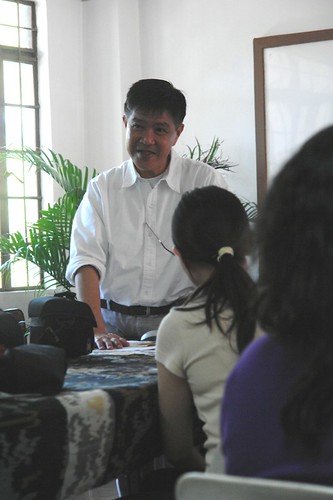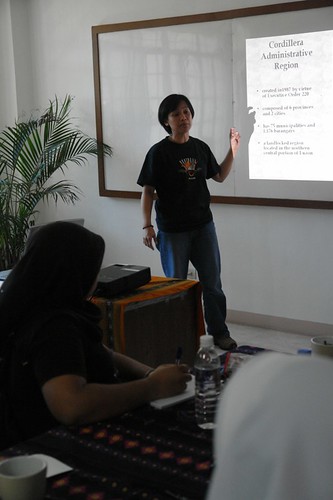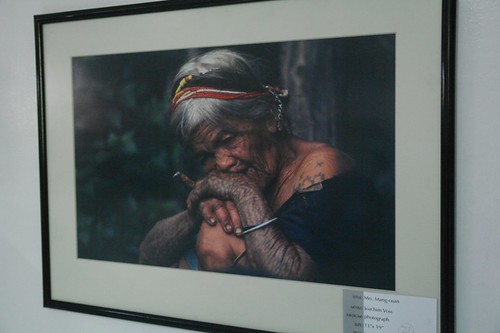 As we lounged in a meeting room overlooking the rows of pine trees dotting the campus grounds, Professor Delfin L. Tolentino (or simply Delfin) walked us through the richly diverse and somewhat complex university system (to our Malaysian ears) in the Philippines.
As we lounged in a meeting room overlooking the rows of pine trees dotting the campus grounds, Professor Delfin L. Tolentino (or simply Delfin) walked us through the richly diverse and somewhat complex university system (to our Malaysian ears) in the Philippines.
Alice, part of the CSC research team then took on the task of explaining the background of Cordillera and the history of the CSC. The CSC which was established in June 1980, was established as a research sector of the Development Studies Program of the then Division of Social Sciences.

The CSC has essentially carved out UPB’s reputation as the lead research university in the Philippines and was reorganized as the university research center of UPB. As such, it sets the research directions of the University.
We were told that despite its namesake, the CSC is not only concerned with research within Cordillera itself but branches into four divisions, (1) Biodiversity Conservation; (2) Ethnicity Studies; (3) Governance and Public Policy; and (4) Local Language and Literature.
The CSC was established to serve as a venue to conduct research pursued by the UP Baguio as well as a platform for the exchange of information and dialogues among academics, social science practitioners, government officials and communities on regional development plans. It seeks to create a positive environment that encourages collaborative and multidisciplinary research, especially regarding developmental issues that involves the Cordillera communities. One of the center’s aims is to ensure full and substantive participation of all concerned parties, hence giving a voice to the indigenous communities as well. Nonetheless, the CSC is not just doing pure academic research but also actively forms close linkages with the local communities and respond to social issues.
Some of the issues of interest to the CSC are such as biodiversity conservation, governance and public policy, and ethnic studies. The center looks at how certain government initiated developmental policies could affect the Cordillera indigenous people and their cultural, political and socio-economic situation. The Center’s library has also became the Cordillera regional information, resource and referral center with its substantial collection of ethnographies and materials on developmental issues, economic change, social transformation and upland resource management. In addition, the CSC also provides research affiliation to local and foreign researchers such as our Monash lecturer, Dr Yeoh, by serving as institutional base and support.

The talk by the CSC has enlightened us about the people and their cultures in the Cordillera region. The Cordillera region is consisting of six provinces and they are Apayao, Abra, Kalinga, Mt. Province, Ifugao and Benguet; and have two chartered cities – Baguio and Tabuk. We were briefed about the diversity of indigenous groups in the six provinces such as the Ibaloy, Bontok, Kalinga, Isney, Gaddang and etc who come under the umbrella term Igorot. Igorot originated from the Spanish word I (from) and golot (mountain) hence the meaning from the mountain.
Essentially, the exposure to the CSC made us realize the importance of having a flagship research center. For without primary field research, larger social issues cannot be addressed.
by Eunice and Maxine
For more photos on Day 2, head over here
hello eunice and maxine.^^ so sorry... it's just now i got to read you entry. :>
ReplyDeletehmmm... comments... hmm.
>the university system of the University of the Philipines wont probably sound so complex if we put it this way: UP is just like Monash University in that both universities have more than one campuses. The flagship campus of Monash is in Australia and it has campuses in South Africa, Malaysia, Italy, etc. UP's flagship campus is in Diliman, Quezon City and there are other campuses, too. If I were to push the analogy *hehe* further, Monash Malaysia's equivalent campus in the UP system would be UP Baguio, no less! I leave it to you to come up with reasons why. ;-)
>the word "Igorot" is a word from a Philippine language. "i-" is a common prefix in Phil. languages; it means, as you said, "from/ person from" and "golot" has cognates not just in Northern Philippine languages, but in Southern Phil languages, as well. "from" in spanish would be "de" and mountain would be "montaña", that is, when we translate literally. hehe.
layad from Baguio,
maya =]
[url=http://kfarbair.com][img]http://www.kfarbair.com/_images/logo.png[/img][/url]
ReplyDeleteמלון [url=http://www.kfarbair.com]כפר בעיר[/url] - אינטימיות, [url=http://kfarbair.com/services.html]שקט[/url] . אנו מספקים שירותי אירוח מיוחדים גם ישנו במקום שירות חדרים המכיל [url=http://www.kfarbair.com/eng/index.html]ארוחות רומנטיות[/url] במחירים מיוחדים אשר יוגשו ישירות לחדרכם!
לפרטים נוספים נא גשו לאתר האינטרנט שלנו - [url=http://kfarbair.com]כפר בעיר[/url] [url=http://www.kfarbair.com/contact.html][img]http://www.kfarbair.com/_images/apixel.gif[/img][/url]